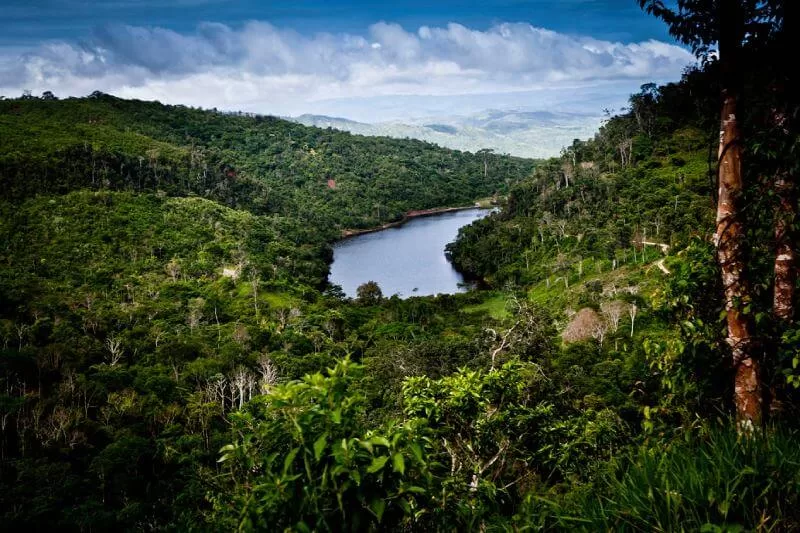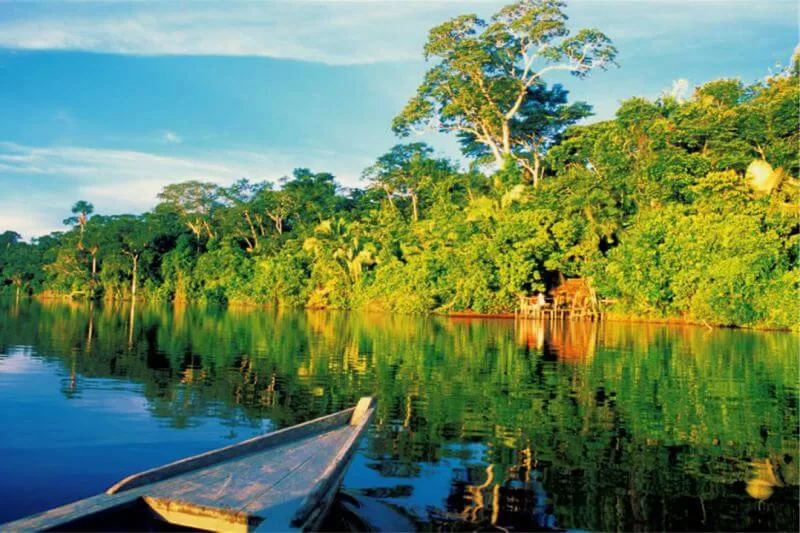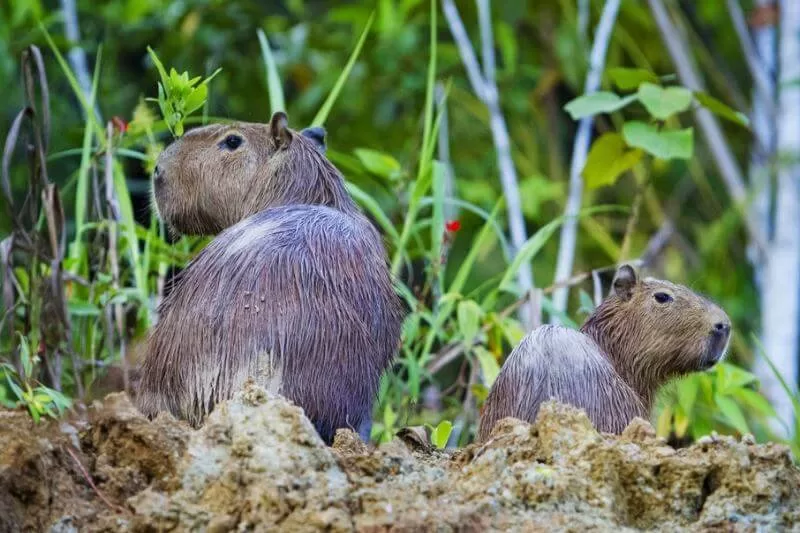Biodiversity in Manu is amazing. This National Park is a sanctuary brimming with biodiversity. Yet, many don’t understand the extent of that. Some of Manu’s secrets explain the biodiversity of the reserve.
This post explores why this park is so biodiverse, the geography, the conditions and more. Also we will unveil its significance to our planet as a place for conservation. There are a lot of phenomena that intervene to make Manu what it is.
Join us as we dive into the untold story of Manu’s biodiversity. Discover the symbiotic relationships that thrive in it. Learn about the inner workings of this biodiversity reserve. We aim to make you see the Manu with a new light and depth when you visit.
Manu National Park in Peru stands as a testament to nature’s splendor. Its geography is a kaleidoscope. Mountains, rivers, and forests converge here. This convergence is key to understanding the park’s rich biodiversity in Manu.
The park stretches from the Andes to the Amazon Basin. Such varied terrain supports diverse habitats. Each habitat fosters unique species. They all contribute to the biodiversity in Manu.

The Manu River carves its way through the land. It acts as a lifeline. Around it, life flourishes in abundance. The river supports ecosystems and sustains indigenous people.
Riverbanks host a plethora of tree species. These trees offer food, shelter, and breeding grounds. They maintain biodiversity in Manu. The river shapes the landscape. This landscape is ever-changing.
Manu’s elevation ranges dramatically. From Andean grasslands to dense Amazon rainforest, elevation influences climate. And climate dictates life. Higher up, cloud forests harbor orchids and hummingbirds.
Lower down, the Amazon rainforest dominates. Here, species of mammals and bird species abound. Elevation creates microclimates. These microclimates are hotspots for biodiversity in Manu.
Manu National Park is a protected area. It’s split into zones. The reserved zone is strictly for conservation. It’s a haven for species. The cultural zone allows for indigenous practices.
Protected areas safeguard Manu’s pristine forests. They ensure the survival of countless species. They keep the biodiversity in Manu. It allows for scientific study and ecotourism, like the Manu Amazon tour.
Trees tower above, creating a canopy. This canopy is an ecosystem of its own. It houses diverse species and supports life below.
The forest floor, meanwhile, has its role. Decomposers break down matter, recycling nutrients. This cycle is essential for life. It’s a key element of biodiversity in Manu.
Manu National Park’s future hinges on conservation. Efforts to preserve its ecosystems are critical. These efforts ensure that Manu remains a bastion of biodiversity. They protect it from threats like deforestation and climate change.
In the heart of the Peruvian Amazon, Manu National Park stands as a beacon of biodiversity. This park, rich in life, hosts unique species. They form the fabric of this ecosystem. Today, we delve into the lives of these guardians of the green.
The park’s vast expanse covers the Amazon Basin to Andean grasslands. This diversity offers a haven for species. From towering tree species to elusive mammals, Manu is alive. Its inhabitants underscore the biodiversity in Manu.
Manu is a paradise for birdwatchers. Over 1,000 bird species make the Manu their home. The harpy eagle reigns supreme. With its formidable size, it patrols the canopy.
The Andean cock-of-the-rock, vibrant and unmistakable, adds to the park’s allure. These birds are more than beauty; they’re indicators of the health of biodiversity in Manu.
Bird species play vital roles. They pollinate plants and disperse seeds. This activity is crucial for forest regeneration. It’s a cycle that sustains biodiversity in Manu.
Manu’s forest is full of unique mammals. The jaguar roams the lowland rainforest. Its presence speaks about the health of the ecosystem. If the jaguar thrives that means all the species that it preys in, have healthy populations.
Then there’s the giant otter in the Manu River. These mammals are keystones. They influence the balance of their environments. Their survival is paramount to maintaining biodiversity in Manu.
Species of mammals in Manu are diverse. They range from the nocturnal ocelot to the elusive spectacled bear. Each has adapted to thrive in specific niches. This adaptation showcases the park’s vibrant biodiversity.

Beyond mammals and birds, Manu harbors a micro-world. Insects and amphibians abound, each with a role. These smaller creatures pollinate plants and break down waste. They’re the unsung heroes of biodiversity in Manu.
The cloud forests and lowland rainforests are teeming with life. Here, frogs with colors as vivid as jewels make their home. Insects, in their millions, form the base of the food web. This microcosm is essential for the park’s biodiversity.
Manu National Park is a model for conservation. The reserved and cultural zones ensure protection and sustainable use. These areas are sanctuaries for the unique species of Manu. They safeguard the park’s pristine forests.
Protected areas provide ecosystem services. They offer clean air, water, and a stable climate. This protection is vital for both wildlife and indigenous people. It’s a cornerstone in preserving biodiversity in Manu.
The future of Manu National Park hinges on continued conservation efforts. Protecting its unique species is not just a local concern but a global one. The biodiversity in Manu is a testament to nature’s resilience and beauty.
Efforts to preserve Manu’s ecosystems are ongoing. They require support and awareness. Through education and sustainable tourism, like the Manu Amazon tour, we can contribute. We can ensure that the guardians of the green remain in their forest haven.
Manu National Park in Peru has a critical role. Here, conservation efforts shape the future. In this section we will explore the pivotal role of conservation in preserving biodiversity in Manu.
The park spans from the Andean grasslands to the Amazon rainforest. This range creates a mosaic of habitats. Each habitat supports unique life forms. These areas are critical for the biodiversity in Manu.
Manu is divided into zones: reserved, cultural, and others. The reserved zone is strictly for conservation. It is off-limits to tourism and most human activity. This protection is key to maintaining biodiversity in Manu.
Protected areas act as refuges for species. They allow ecosystems to function undisturbed. This is crucial in the fight against climate change. They filter water, store carbon, and pollinate crops.
Indigenous people play a critical role in conservation. They are the park’s first stewards. They live in harmony with nature. The understanding they have enlight conservation efforts.
The cultural zone allows for traditional practices. It ensures that indigenous ways of life continue. This zone shows that conservation can include human activity. It’s a model for sustainable living.
Manu’s biodiversity is intricate. Each species depends on others for survival. Trees provide habitat for bird species. Birds, in turn, disperse tree seeds.
This interdependence is the base of the biodiversity in Manu. Every species adapts to the needs of others and the resources they can take from that. Everything is about balance.
Species of mammals, birds, and insects all play roles. They pollinate plants, recycle nutrients, and control pests. This biodiversity ensures the health of the ecosystem. It makes the park resilient to changes.
Despite its protected status, Manu faces threats. Illegal logging, mining, and climate change loom large. These activities disrupt habitats. They threaten the biodiversity in Manu.
Conservation efforts combat these threats. They aim to preserve the park’s pristine forests. This includes monitoring species, restoring damaged areas, and enforcing protected status. These efforts are vital for the park’s future.
The future of Manu National Park depends on continued conservation. This work requires global support. It involves research, funding, and policy making. These efforts ensure that Manu remains a haven for biodiversity.
Education and ecotourism play roles too. They raise awareness about the importance of conservation. Tours, like the Manu Amazon tour, show the beauty of the park. They inspire visitors to support preservation efforts.

If you got any questions, please do not hesitate to send us a message. We reply within 24 hours!
+51 900 394 399
info@biomanuexpeditions.com
reservas@biomanuexpeditions.com
